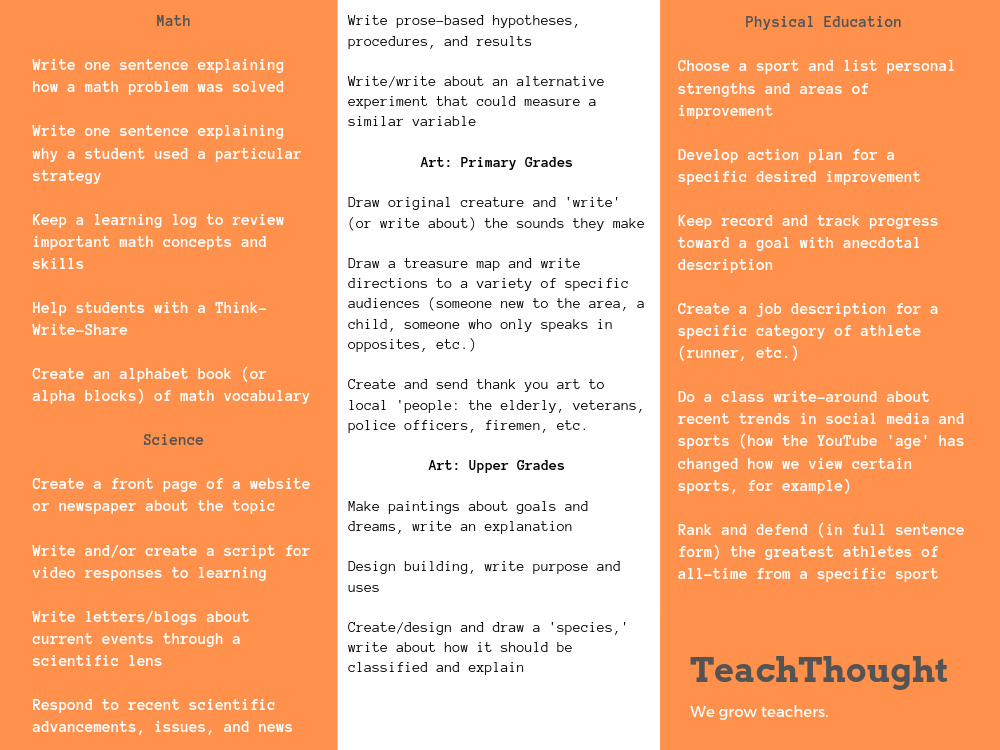
20 Ideas for Incorporating Writing In Other Subject Areas
by Barbara R. Blackburn, PhD and TeachThought Staff
Teaching writing is traditionally though of as an ‘English Language Arts’ responsibility rather than viewed as the responsibility of the ‘writing teacher.’
While that’s a longer, more complex conversation (with some truth), hopefully we can agree for now that writing has significant potential to help students learn those ‘other content areas’ like math, science, social students, art, physical education, and so on. Like speaking and listening, writing isn’t ‘one more thing to teach’ but rather a tool to help students learn whatever it is you’re teaching.
2 Research-Based Literacy Recommendations
1. Increase Amount of Writing Time
It is critical to use rigorous, evidence-based instructional strategies within the MTSS framework. In our experience, all students can learn at rigorous levels, if we provide appropriate instruction that incorporates support and scaffolding. Here, let’s look at two specific research-based literacy recommendations: providing differentiated reading instruction and increasing how much students write.
2. Differentiating Ready by Layering Meaning
When we were working with at-risk students, we used a strategy called layering meaning to help them read and understand their social studies textbook. Because our students were reading below grade level, they struggled with the text. So we found an article or section from another book on the same topic that was easier to read. However, many times, the teachers we work with stop at that point.
With layering meaning, students read that material first, which helps them build background knowledge and learn some of the specialized vocabulary. Then, students return to the main text and read it with your support. Since they have read the easier text, they are better able to handle the grade level text, which is more rigorous. As they progress through the year, some students will no longer need the extra step. Others, however, need the continued support.
On the other hand, for students who are more advanced, they start by reading the standard or grade level text. Then, they read text that is written at a higher level for more advanced work. This lets you differentiate the reading assignments based on the skill level of your students. You will need to find text at varying levels of text for this strategy. Larry Ferlazzo provides sample sources for leveled text you can find here.
It is also important to increase the overall amount of time students write in the MTSS classroom. Although this can be a formal writing lesson, or a large project like a research paper, you can also incorporate writing in small ways throughout lessons in any subject area. These include exit slips, writing letters or postcards to summarize information, keeping learning logs or journals, or working together for collaborative note-taking where each student in a group summarizes one section of the text and then students share information.
20 Suggestions for Incorporating Writing In Other Subject Areas
Math
Write one sentence explaining how students solved problem
Write one sentence explaining why a student used a particular strategy
Keep a learning log to review important math concepts and skills
Do a Think-Write-Share
Create an alphabet book (or alpha blocks) of math vocabulary
Science
Create a front page of a website or newspaper about the topic
Write and/or create a script for video responses to learning
Write letters/blogs about current events through a scientific lens
Respond to recent scientific advancements, issues, and news
Write prose-based hypotheses, procedures, and results
Write/write about an alternative experiment that could measure a similar variable
Art
Primary Grades
Draw original creature and ‘write’ (or write about) the sounds they make
Draw a treasure map and write directions to a variety of specific audiences (someone new to the area, a child, someone who only speaks in opposites, etc.)
Create and send thank you art to local ‘people: the elderly, veterans, police officers, firemen, etc.
Upper Grades
Make paintings about goals and dreams, write an explanation
Design building, write purpose and uses
Create/design and draw a ‘species,’ write about how it should be classified and explain (this is as much science as it is art)
Physical Education
Choose a sport and list personal strengths and areas of improvement
Develop action plan for a specific desired improvement
Keep record and track progress toward a goal with anecdotal description
Create a job description for a specific category of athlete (runner, etc.)